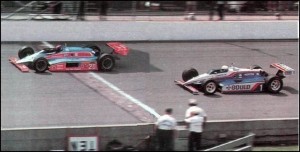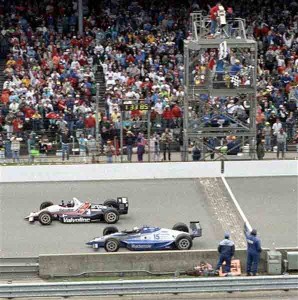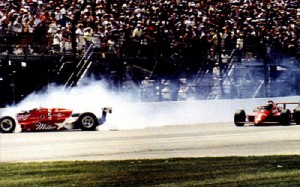Great Memories from 100 Years of the Indianapolis 500
This year’s running of the Indianapolis 500 marks the 100th anniversary of the first race back in 1911 and has been run every year with the exceptions of 1917-1918 and 1942-45 because of the two World Wars.
While the race has lost much of its stature as one of the biggest sporting events in America, the race still has special mention for many drivers and racing fans throughout the world.
With that in mind, here are the ten most memorable Indianapolis 500s of all time:
10. 1977
A.J. Foyt becomes the first driver to win the Indianapolis 500 four times as he takes the lead with sixteen laps to go when leader the crankshaft on Gordon Johncock’s car breaks.
The race is also historic for having Janet Guthrie, the first female driver ever to race in the Indy 500, as she starts the race 26th but falls out of the race after 27 laps because of a gearbox failure.
9. 1960
Jim Rathmann and Rodger Ward engage in a duel for the ages as the two drivers swapped the lead 14 times in the last 78 laps, the last lead swap coming on the 197th lap when Rathmann passes Ward after the cord on the right front tire of Ward’s car wears down, causing him to fall back.
Rathmann goes onto win the race over Ward by 12 seconds for his only win in the Indy 500.
8. 1989
Emerson Fittipaldi dominated the 1989 race by leading 156 of the first 195 laps, but was passed by Al Unser Jr. with five laps to go and had to come from behind to win the race in the final laps.
On the next-to-last lap, Fittipaldi caught “Little Al” and was side-by-side with him going into turn three when the right front tire of Fittipaldi’s car touched with the left rear tire of Unser’s car, causing Unser to spin out and crash, while Fittipaldi continued on to take the white flag and the yellow flag as the leader of the race.
As Fittipaldi came back around on the final lap, Unser Jr. saluted the former 2-time Formula 1 champion as Fittipaldi went on to win the first of two Indianapolis 500s in his career.
7. 1985
Thinking there are only a handful of laps to go, Danny Sullivan pulls out an aggressive move and passes leader Mario Andretti in turn 1 of the 120th lap.
But as Sullivan comes off the apron to complete the pass, his car swerves causing Sullivan to lose control and spin in the short chute between turns 1 and 2.
Sullivan does a 360-degree spin and keeps it off the wall, to continue in the race.
Twenty laps later, Sullivan passes Andretti again and stays in the lead for the remainder of the race to win his first and only Indy 500, where Mario finishes 2nd.
The race is now known as the “Spin and Win”.
6. 1981
After a pit stop on lap 149, leader Bobby Unser exits pit road and passes 14 cars before he blends into traffic, which is against the rules. Unser would go on to finish first in the race, but a protest is filled by runner-up Mario Andretti’s team, claiming that Unser should have been penalized for passing cars under the caution.
The next morning, USAC officials asserted a 1-lap penalty to Unser, dropping him to second place and declaring Andretti the winner.
Roger Penske, the owner of Unser’s car, appealed the decision and four months later, Unser is reinstated as the winner of the race.
5. 2005
Danica Patrick makes history as she becomes the first female driver to lead laps in the Indianapolis 500, then passes leader Dan Wheldon with on the 190th lap following a restart.
But having to save fuel, Patrick loses the lead to Wheldon four laps later and drops back to fourth place, while Wheldon goes on to win the race.
Still, Patrick’s finish is the highest finish for a female driver in the Indy 500, a feat Patrick topped in 2009, with a third-place finish.
4. 1987
Beginning the month without a ride and filling in for an injured Danny Ongais in a backup car, Al Unser Sr. becomes the oldest driver to win the Indianapolis 500.
Mario Andretti dominates the race as he leads all but seven of the first 177 laps, but a failure in the fuel injection system causing his car to slow and drop off the pace, in another incident of the famous “Andretti Curse” at Indianapolis.
Roberto Guerrero takes the lead and has a one-lap margin over second place Unser Sr., before coming into the pits for his final pit stop.
But after the pit stop is completed, Guerrero stalls the engine and by the time he gets the engine refired, he is almost a full lap behind Unser Sr.
“Big Al” leads the final 18 laps to become the second driver to win four career Indy 500s.
3. 1982

After losing most of a 12 second lead, Gordon Johncock held on to defeat Rick Mears in the 1982 Indianapolis 500.
It appeared Gordon Johncock was on cruise control after his final pit stop as he assumed a 12-second lead over Rick Mears with 13 laps remaining.
But the handling on Johncock’s car severely deteriorated and Mears was able to cut a second per lap over the final 13 laps.
By the time the two drivers received the white flag, Mears was right behind Johncock and pulled alongside him going into the first turn on the final lap.
However, Johncock was able to keep the lead and then held off Mears’ last-chance slingshot pass on the front stretch, to win the race by .16 of a second, the closest finish in Indy 500 history at that time.
The 45-year-old Johncock won his 2nd 500 in what is now the third-closest finish in history.
2. 2006
Sam Hornish Jr. overcomes a drive-through penalty that places him nearly 30 seconds behind of the leader, and becomes the first driver to win the Indy 500 on a last-lap pass.
A late-race caution bunches up the field with Hornish Jr. in fourth place and Michael Andretti in the lead, with his son, Marco, in second.
The race restarts with four laps to go and Hornish passes Scott Dixon for third place while Marco passes his father going into the first turn on the 198th lap and takes the lead.
Hornish takes over second place on the backstretch of that very same lap and catches Marco by the turn 3 of lap 199, but his momentum is blocked and Andretti pulls out to a one-second lap as he takes the white flag for the final lap.
But Hornish reels Marco in and slingshots past him in the last 400 feet and beats Andretti to the finish line by O.0635 seconds, the second-closest finish in Indy 500 history.
1. 1992
From start to finish, the 1992 race is the wildest race in the 100-year history of the Indianapolis 500.
The race was run under an overcast, cold afternoon with a wind-chill of 36 degrees, making it difficult for the drivers to warm up the tires on their cars, thus leading to more accidents.
In all, there were 13 cautions during the race, seven of them because of accidents, sending several drivers to go to the hospital for injuries including Rick Mears, Emerson Fittipaldi, Mario Andretti, and Jeff Andretti.
Mario’s son and Jeff’s brother, Michael, dominated the race as he led 160 laps, but on the backstretch of lap 190, Andretti’s car slowed down, coming to a complete stop because of a faulty fuel pump.
Al Unser Jr. inherited the lead with Scott Goodyear right behind him in second place as the race restarted with seven laps to go.
The two drivers drove nose-to-tail for the final seven laps until the final turn when Goodyear pulled alongside “Little Al” on the front stretch, only to fall half a car length short, or 0.043 seconds, the closest finish in Indianapolis 500 history.
And here are three other 500s that need to be mentioned:
1986-Bobby Rahal passes Kevin Cogan on a restart with two laps to go and pulls away to win his first Indy 500 in the closest three-car finish in Indy 500 history as 1.8 seconds separate Rahal from third place Rick Mears, with Cogan .4 seconds ahead of Mears and 1.4 seconds back of Rahal.
Rahal wins the race for his car owner, Jim Truman, who died 11 days after the race because of cancer.
1991-On a restart with fourteen laps to go, Michael Andretti makes a daring pass on the outside of Rick Mears in Turn 1, to retake the lead, only to have the normally conservative Mears, repeat the exact same pass in the same turn one lap later.
Mears would pull away and wins his fourth career Indy 500, joining A.J. Foyt and Al Unser Sr. as the only drivers to win the Indianapolis 500 four times.
2002-Approaching the third turn on the 199th lap, Paul Tracy gets alongside Helio Castroneves and appears to pass him for the lead before the caution light comes on for an accident that happens behind the two leaders.
Indy Racing League officials rule that Castroneves was leading at the time of the caution, and goes on to win the race for the second year in a row.
Tracy and his team would protest the decision, but the IRL upheld the decision with Castroneves as the winner.


BION I’m ipmrsesed! Cool post!
jOeEN3 hsfsrrapxlwm
nice